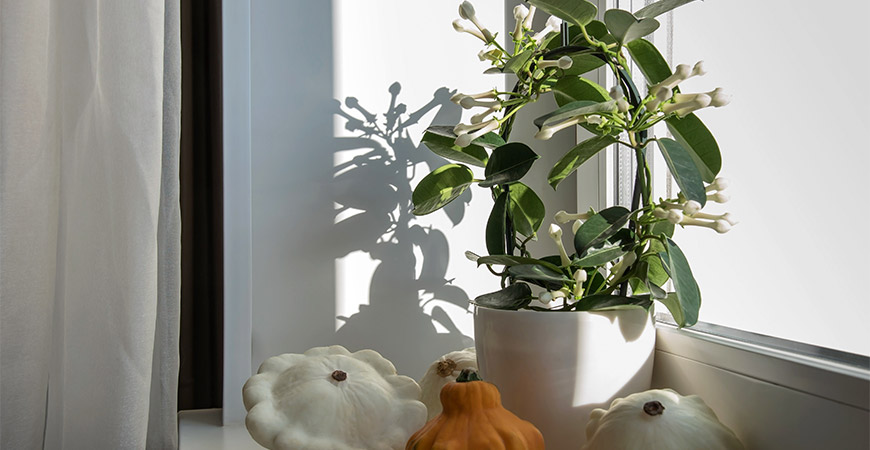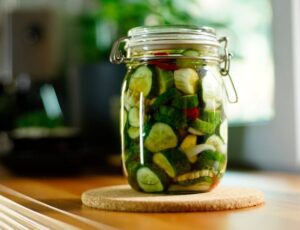
How to Overwinter Tropical Plants
When fall temperatures dip, it’s time to bring tender tropicals indoors. Move your plants inside the house or to a sheltered area in late summer or early fall when the weather is mild but not too cold.
Why? A plant moved from chilly weather to a heated room may cause plant shock.
Here we’ll cover how to overwinter cold-sensitive tropical plants.
How should I store my tropical plants?
If you’ve grown tropical plants in your yard, on the deck, or by the pool this summer and wish to keep them alive until next spring, there are three ways you can store them –
- Set them in a warm, sunny spot, such as a south-facing window or sunroom. Or outside in a greenhouse. Keep the plant’s leaves from touching cold windows.
- Take a leaf or stem cuttings, root them in a rooting medium and plant them in a pot for new plants next year. Put the rest of the plant in the compost pile.
- Let the tropical plant go dormant. Store it in a cool, dark place such as a closet or basement.
What types of tropical plants can I overwinter?
If you have a room with a sunny window and the indoor temperature stays between (60 to 70 degrees), it is possible to overwinter your cherished tropical. Some will even grow in winter.
Allamanda, bamboo, bougainvillea, citrus, cordyline, hibiscus, jasmine, and palm are a few tropicals that can be overwintered in a sunny window.
Store Banana leaf, brugmansia, and dwarf cannas in a cool, dark location such as a basement, hall closet, or unused bedroom.
Also, store the dormant bulbs, tubers, or corms from begonia, caladium, calla, cannas, dahlia, ginger, and sweet potato vine.
Set small tropicals under a grow light for their winter nap. Set the grow light to a 12-hour timer, so the plants have sufficient light.
When should I move my tropical plants inside?
Bring your tropical plants inside when the weather is mild during the day and evening temperatures turn chilly. Move them to shelter before the first frost. It’s ok for a few leaves to drop while they are getting used to living indoors.
How often should I water my stored plants?
Water plants minimally, just so the soil is slightly dry. To keep insects and disease at bay, place pots a minimum of 2 inches apart for good air circulation. Move the air by running a small fan and adding humidity by misting plant foliage or placing a saucer of water near plant containers.
How do I get rid of bugs on my tropical plant?
Tropicals enjoy winter temperatures of 65 degrees during the day and 50 degrees at night. Warmer temperatures will encourage insect problems. The most common insects you may find include scale, spider mites, and whiteflies.
Inspect your plants weekly for signs of pests. Most bugs can be controlled with insecticidal soap.
If you find numerous insects on a plant, wash the foliage in water mixed with a squirt of dishwashing liquid. Set large plants in the tub or shower and spray to remove bugs. Let the leaves dry, and then spray the plant with insecticidal soap.
Should I prune my overwintered tropical plants?
Plants that still grow during winter can benefit from one or two prunings. Pruning will keep the plant in balance. Coleus, geraniums, and plectranthus respond well to a winter trim.
How do I root tropical plant cuttings?
Soft-stemmed tropicals such as coleus, geranium, and plectranthus can be challenging to overwinter. Trim young, pliable stems from plants, place the stem ends in a container of water, and set them on a sunny windowsill.
When you see roots, plant the cuttings in a small pot, and place them under a grow light or in a sunny spot. Routinely add fertilizer, and you’ll have new tropical plants to enjoy next spring.
How do I reintroduce tropical plants to the outdoors in spring?
Gradually acclimate your plants to warm spring temperatures. Begin by setting the plants outside in the shade, away from breezes, for one to two weeks.
Slowly reintroducing your plants to spring temperatures will give them a healthy start. Plants that are exposed to outside temperatures too quickly may be stressed.
Here’s a few additional tips for overwintering your tropical plants

Plan Ahead
Move tropical in early autumn or when milder temperatures arrive. Don’t wait until frost arrives, as they will not like the sudden switch from the chilly outdoors to the warm, dry indoors.
Insect Inspection
Before bringing your plants indoors, check them for bugs or small stowaways. Insects, pests, spiders –even small frogs or lizards may be hiding in the foliage. To ensure no insects make their way in, spray the foliage with insecticidal soap and allow it to dry before bringing it inside.
Give Plants a Shower
Spray plants with a garden hose to clean foliage, remove loose leaves, and remove insects.
Diet Time
Fertilizer encourages plant growth, so use less fertilizer as summer fades to slow down plant growth before overwintering.
Detective Work
Dry, warm indoor air can encourage pests, so check your overwintered plants weekly for insects or diseases. Keep bugs away by misting plants daily, or set them in the sink and spray with a gentle stream of warm water.
Check the Temperature
Overwintered plants prefer consistent daytime temperatures between 70 and 80ºF and nighttime temperatures between 55 and 65ºF. Keep plants away from heating ducts as the warm, forced air can cause dryness. And keep them away from outside doors as cold air can affect the foliage.











